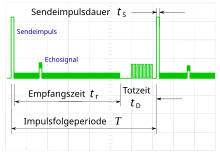Pulse repetition rate
The pulse repetition frequency ( English Pulse Repetition Frequency , PRF, literally " Pulse Repetition Frequency ") of a radar device is the number of transmitted pulses in relation to the duration of the count. The radar device sends a short, high-frequency pulse with the transmission pulse duration (pulse width ) and waits for the echo signals between the transmission pulses. The time from the start of a transmit pulse to the start of the next transmission pulse (pulse repetition period English Pulse Repetition Time , PRT) called and is the reciprocal of the pulse repetition rate:
The time between the transmission pulses is generally the reception time. This is always smaller than the difference between the pulse train period and the transmission time and is sometimes additionally limited by a so-called dead time. In the dead time before the next transmission pulse, system tests ( built-in test equipment BITE ) are carried out on modern radar devices .
Ambiguous time measurements
The pulse repetition frequency of a radar device must ensure that the reception time lasts long enough to receive echo signals from distant objects. If the pulse repetition frequency is too high, echo signals that arrive too late can lead to measurement errors. Ambiguous results of the range calculation are now possible because two transmission pulses can be the cause of the echo signal. These echo signals are often named with the English term ambiguous returns , sometimes the German term distance folding is also used.
The maximum possible distance for a clear measurement result (so-called "unambiguous return") can be calculated using the following formula:
With
- PRT = pulse repetition time
- = Pulse duration
- = Speed of light
The pulse repetition time PRT must be sufficient for the outward and return path of the electromagnetic wave, so the range is only half of the path covered by the electromagnetic wave. The pulse duration is included in this formula because the entire transmission pulse must be received before a target can be generated for the display device. (This restriction is particularly important for radars that work with the pulse compression method and very long transmission pulses.)
Suppression of ambiguities
Despite a sufficient reception time, abnormal propagation conditions of the electromagnetic waves can lead to overreaches. These overreaches have a different meaning for radar devices than the overreaches in radio links for communication. In the case of such overreaches, the radar device can often no longer establish a reference to the time system. These echo signals are then displayed at the wrong distance. There are several possibilities to prevent such ambiguous returns:
- Choice of a very low pulse repetition rate;
- Use of a staggered PRT, i.e. a constantly changing duration of the reception time;
- certain intrapulse modulation methods.
Size of the pulse repetition rate
The pulse repetition frequency cannot be reduced arbitrarily. The data renewal rate, which requires the highest possible pulse repetition rate, also depends on this parameter of the radar device. The size of the pulse repetition frequency is therefore a compromise.
Staggered PRT
In older radar devices, “staggered PRT” is a way of recognizing these incorrect measurements as such. The English term staggered means as much as staggered or offset. Variable pulse train periods (PRT) are used to protect against interference caused by overreaching and to avoid blind speeds .

With a staggered PRT, the interval between the transmission pulses is not constant. Echo signals from overreaches therefore have no constant time reference to the wrong PRT and can therefore be recognized as overreaches.
More modern radar devices with digital radar signal processing can recognize this offset response and still try to display the echo signals from overreaches at the correct distance. This process is also called "removal ent folding" called.
Intrapulse modulation
With the intrapulse modulation process , an additional frequency is modulated on within the transmission pulses. If this modulation is not constant, the radar signal processor can assign an echo to its transmission pulse, even if the echo comes from a different pulse period. Non-constant modulations can be realized by coded pulse-phase modulation and even by a pseudo-random pulse pattern, which is as similar as possible to white noise .






